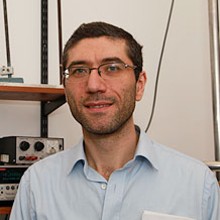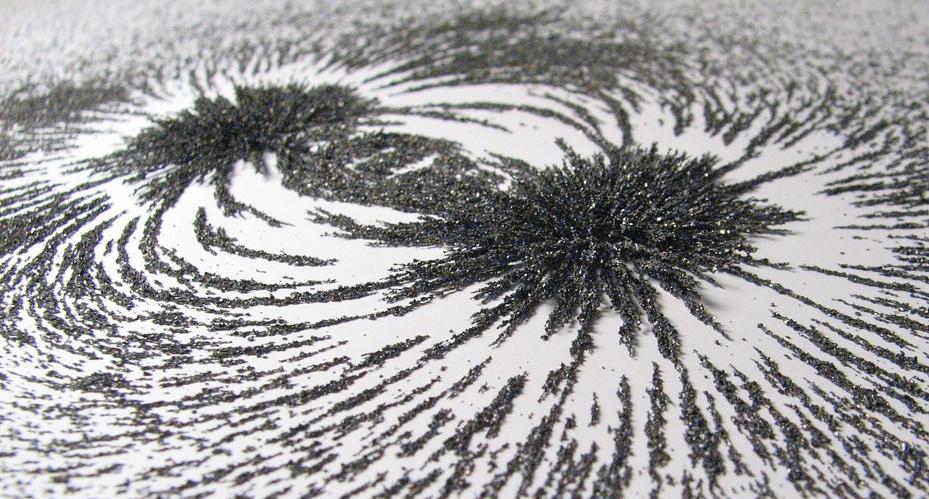Magnetic Materials
Magnetic Materials
Magnetic Materials
Magnetic Materials
Research groups associated with magnetic materials at Exeter
- Electromagnetic and Acoustic Materials (EMAG)
- Nano Engineering Science and Technology Group (NEST)
- Quantum Systems and Nanomaterials (QSN)
Contact us: metamaterials@exeter.ac.uk
Equipment and facilities
- Exeter time-resolved magnetism facility (Extremag)
- List of measurement facilities (ultrafast, microwave and magnetic, and acoustic)
Case studies
- Communicating in a crowded electromagnetic environment – how metamaterials can give us more space
- EAS tags - metamaterials can protect merchandise where standard security tags fail
Professors
Professor Alastair Hibbins

Manipulation of electromagnetic waves
Much of the work that I’m involved in seeks to manipulate electromagnetic waves using metamaterials. Some of our recent work has demonstrated that composite materials, with small (compared to the electromagnetic wavelength) resonant or scattering inclusions embedded within a passive host, offers exciting potential. We have explored how ferrite and carbon-iron micron-sized inclusions can yield magnetic behaviour beyond the frequency limits we normally expect. They offer the potential to fabricate impedance matched and absorbing materials in the GHz range, as well as benefiting microwave devices and antenna systems in this important part of the spectrum. This area of work is a collaboration with Dr Mustafa Aziz, and Profs Sambles and Ogrin - it includes analytical, modelling and experimental strands, with state-of-the art magnetic modelling systems (MaxLLG), and material characterisation facilities offering measurements up to 50 GHz.
Professor Euan Hendry

THz materials, imaging and spectroscopy; Nonlinear optics
We explore the potential for developing new THz components and sensors to fill the so-called “THz gap”, utilizing novel magnetic and plasmonic responses of many materials in this region, and are currently working on novel methods for imaging in this difficult spectral region. We also work in plasmonics, and explore the possibility of replacing coinage metals with new materials such as graphene and ITO. These materials have tuneable electromagnetic responses, as free electrons can be controllably introduced by chemical, electrical or photo-doping, making the manipulating light on extreme sub-wavelength length scales possible, and we focus on enhancing nonlinear optical responses for optical switching etc.
Professor Rob Hicken

Magnetic and spintronic materials and devices
The spin angular momentum of the electron underlies the magnetism of materials with permanent magnetic order and is manipulated in spintronic devices. The non-volatility of magnetic order, and the resulting energy efficiency of magnetic and spintronic devices, is highly attractive for information technology. We use a combination of electrical, microwave, optical and x-ray measurement techniques to study new materials that can be controlled at the nanoscale and down to femtosecond timescales to provide improved device functionality.
Group page
Prof Saverio Russo

Quantum Systems and Nanomaterials
My research group is pioneering the novel science found in nano-systems. In particular, we are currently studying the electrical properties of graphene materials, which are just one or few carbon atom thick with honeycomb structure. In these materials charge carriers have a record high mobility at room temperature and behave as massless Dirac fermions.
Our main research directions are
- Graphene-based flexible and transparent electronic devices.
- Novel technologies for fabricating suspended and double gated graphene transistors to access the electric field tuneable low-energy band structure in few-layer graphene and the electro-mechanical properties.
- Search for highly conductive and transparent materials.
- Superconducting-graphene hybrid structures.
Associate Professors
Professor Feodor Ogrin

Bio-inspired magnetic systems
Many microorganisms in the natural world have developed properties which could be invaluable for our technologies. Even a ‘simple’ motion or moving liquid at microscale can help us to revolutionise a range of practices used in medicine and biotechnology. In this research we use magnetic materials to help us creating microscopic machines that would be able to mimic micro-organisms. As well as building and controlling them the main challenge of the research is to find the ways to recreate the mechanics of the biological systems in the highly viscous environment which they are exposed to. Our research is highly interdisciplinary, and as well as the magnetic phenomena includes such disciplines as hydrodynamics, microfluidics, mechanics and electromagnetism.
Prof Janet Anders

Quantum thermodynamics
Our research focusses on providing theoretical understanding of thermodynamic processes at the nanoscale using the tools of quantum information theory and statistical physics.
Within the magnetism theme, we are developing a quantum thermostat that can replace the standard classical thermostat used in magnetic materials simulations. This research will contribute in improving the accuracy of simulations that are crucial for future technologies based on magnetic materials.
Please see here for more information about the Quantum Group.
Professor Mustafa Aziz

Magnetic materials and transducers
The magnetic response of magnetic materials due to the interaction with electromagnetic fields is influenced by the magnetic properties, shape and size of the magnetic structure. Controlling the shape and size of the magnetic structure or constituents offers enhanced magnetic response, tuning capability and improved material aspects (mechanical, electrical, thermal and optical) for manufacturing and industrial applications. My research focuses on the development of theoretical and computational electromagnetic algorithms to understand this complex interaction with discrete and continuous magnetic (meta)materials, and enable the design and engineering of high-frequency, compact composites and devices for data storage, communications and microwave applications. My work in applied magnetics also extends to the research and development of high-sensitivity, high-resolution non-destructive electromagnetic techniques for the detection and characterisation of defects and abnormalities in magnetic structures such as oil and gas steel pipes.
Professor Volodymyr Kruglyak

Magnonics
We study phenomena associated with spin waves (elementary excitations of the magnetic order) and magnons (their quanta). Spin waves carry energy and angular momentum via a collective wave motion of spins. So, the relation between magnonics and the rest of spin physics (aka spintronics) is akin to that between the ac and dc electricity. Magnonics offers the perspective of technology that would use spin waves (or magnons) to carry and process both analog signals and digital data. The most attractive features of this technology are the low power, magnetic reconfigurability and scalability to nanometre dimensions.
Senior Lecturers / Lecturers
Dr Maciej Dąbrowski

Maciej's research focusses on pursuing novel functionalities of condensed matter for applications in spintronics, data storage and quantum technologies. His interdisciplinary approach spans magnetism, plasmonics and ultrafast dynamics. Of particular interest is optical control of 2D van der Waals materials with the ultimate goal of building a new generation quantum platform providing energy efficiencies and operational timescales far exceeding what is possible with conventional electronics. He is also developing new experimental methods to directly probe magnetic and optical properties on the nano-femto scale.

